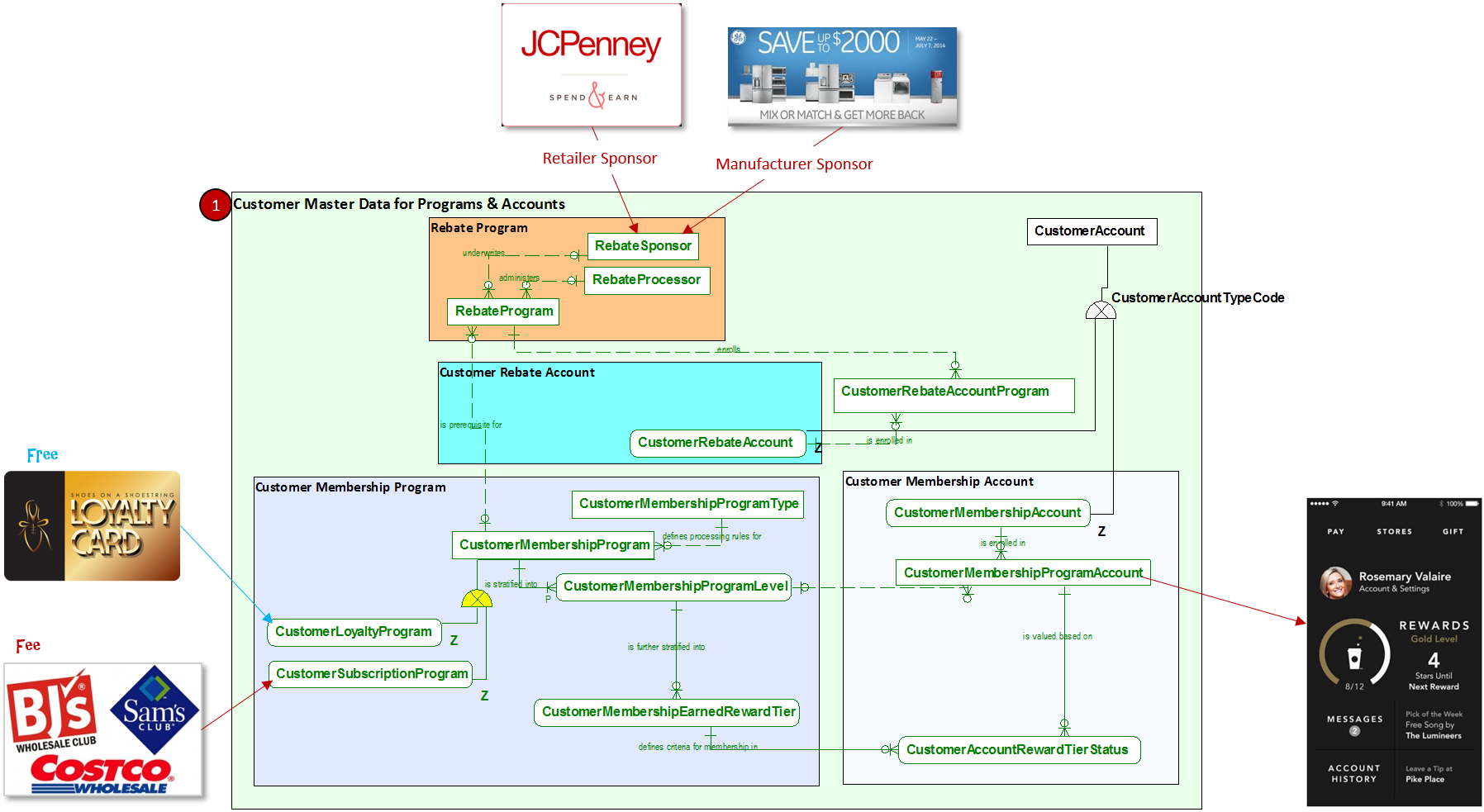Customer Membership Programs and Accounts
Customer membership programs and rebate programs are initiatives sponsored by retailers and/or third parties that provide benefits to identified customers. The customer membership programs involve registering consumers and, optionally charging them a fee to receive special rewards. Rewards are benefits that may be earned and accumulated over time for subsequent redemption (deferred rewards) or they may be benefits that are earned and redeemed as discounts in the same transaction (instant rewards). The entities here identify, define and describe the programs and associated customer accounts used to:
•Identify, authenticate and authorize customer activities related to accruing and spending rewards;
•Qualify customers to receive discretionary rewards (i.e. membership is one of the eligibility criteria required to earn a reward); and
•Provide a place to store and accumulate reward earnings, redemption transactions and adjustments plus an ongoing balance of available reward value;
In the new version of the ARTS ODM membership accounts and programs replace loyalty accounts and programs. The purpose of this change is to provide entities that can represent both paid subscription programs as well as free loyalty programs. As modeled, retailers may establish a number of different paid and free programs.
This new version of ARTS also extends the promotion centered application of eligibility rules, reward derivation rules and redemption transactions to include a broad range of customer membership types. In the prior versions of the ARTS ODM, rewards represented only transaction bounded point of sale markdown derivations. In this version rewards can handle intra-transaction point of sale markdowns plus customer membership based discounts, manufacturer rebates and different combinations of rewards.
Rebate Program
A RebateProgram is a planned set of offers and activities designed to refund cash, merchandise credit, voucher , stored value instrument, etc. to customers who purchase products and services and in so doing satisfy a set of rules defined by the RebateSponsor. Rebate programs may be sponsored by manufacturers, suppliers, utility companies, healthcare companies and public agencies or the retailer itself. Rebate programs may be designed to achieve different outcomes such as increasing sales volume, decreasing the use of electricity, gas, oil and other kinds of energy, promoting healthy living habits, etc. Rebate programs may or may not require customers to be enrolled in retailer customer membership programs (hence the optional FK to CustomerMembershipProgram).
When established and funded by a retailer, a rebate is functionally equivalent to a discount (i.e. it involves a reduction in the retail price charged at the point of sale and reflects a reduction in the retail BASIS for stock ledger reporting and tax purposes). The RebateSponsor is the organization that pays for the cash back benefit received by a customer. The RebateProcessor is the organization that handles rebate claims, makes payments and other administration activities. RebateSponsor and RebateProcessor are both subtypes of PartyRoleAssignment (see Logical 06310 - Party - Role View for details on parties and roles).
Figure 25 - ARTS Customer Membership Programs and Accounts

Rebates may be paid out based on cumulative sales completed through multiple transactions over a period of time. Many club membership programs also include a rebate program in addition to other rewards. To track purchases, returns and adjustments over time a CustomerRebateAccount is required. The CustomerRebateAccount has places to maintain cumulative sales, returns and the current balance of earned rebates. Typically, membership rebate programs redeem accumulated rebates on an annual basis. In the ARTS data model the retailer is free to choose a different time period (e.g. quarterly, semiannually, etc.)
Customer Membership Programs
CustomerMembershipProgram and CustomerMembershipAccount entities are subtypes of CustomerAccount. They represent a persistent link between a retailer and the customer. As with all CustomerAccounts in ARTS a customer must be a KeyCustomer (which means they have registered with the retailer and provided contact information that makes them identifiable when making purchases, returns, etc.) In previous ARTS ODM versions only customer loyalty programs were supported. This approach did not easily accommodate paid club memberships. To address this shortcoming, ARTS replaced loyalty programs with CustomerMembershipPrograms which are generalized and can represent paid membership as well as free loyalty customer programs.
Customer Loyalty Versus Customer Subscription Programs
The ARTS CustomerMembershipProgram is further subtyped into CustomerLoyaltyProgram and CustomerSubscriptionProgram. The loyalty program represents free memberships that allow customers to earn and accrue rewards based on actions they take (like purchasing items, referring customers, visiting retailer online or physical venues, etc.). The CustomerSubscriptionProgram represents fee-based programs that customers pay to participate in to secure everyday low pricing and exclusive product offerings, annual rebates, special promotions, etc. ARTS treats these as two distinct kinds of programs and related program accounts to enable retailers to combine them for marketing purposes but keep them separate for reporting, accounting and analytic purposes.
Customer Account Tiers
Customer membership program may be composed of different tiers. A CustomerMembershipEarnedRewardTier is a reference entity that identifies and names a customer membership earned reward tier or level used to stratify customers based on their level of net purchases, visits, RFM activity and other activities. This entity establishes ranges of values used to bin customers based on activity metrics captured and evaluated on a periodic basis. Activity information is aggregated for the period, compared to the range of values associated with a tier and the customer member account is assigned to the tier where its value falls into the tier high-low range. The term "earned" is used here because customers actions cause them to move between tiers. They may move up to higher-level, higher value tiers or move down to lower level lower value tiers.
The CustomerMembershipEarnedRewardTier is different from the CustomerMembershipProgramLevel in that customer membership account level is a function of its activity not a choice made to join at a given level. The CustomerMembershipProgramLevel supports WarehouseClub and Coop arrangements that feature different levels of membership and are established indpendently of customer activities.